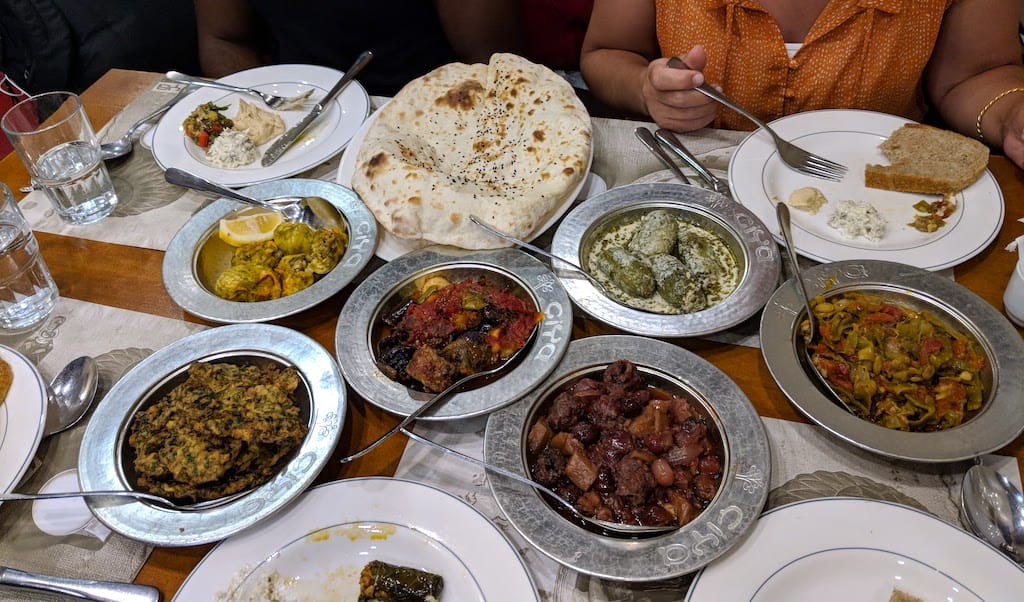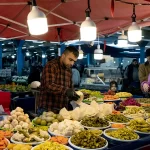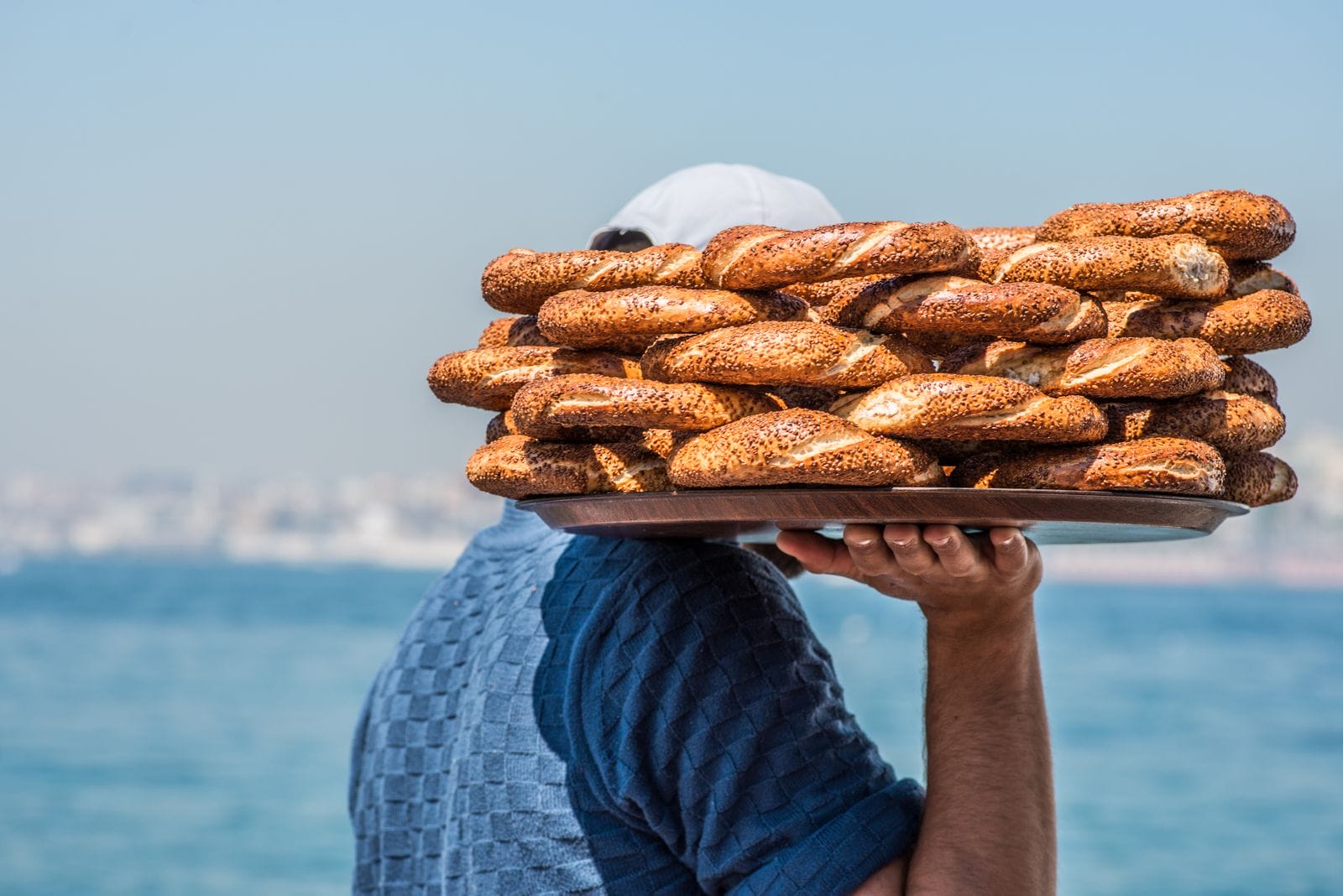With a main terminal of 1.44 million square meters, the new Istanbul Airport (IST) takes a lesson from its home city, paying homage to the gods of unnecessary sprawl and shopping malls. Rather than waste away under the fluorescent lights paying triple the price on duty free and forcing down disappointingly dry pide, store your bags for a few bucks and head out into the city for some unforgettable meals and sights.
When circling into IST or the Asian side of the city’s Sabiha Gökçen Airport (SAW), the unending view of building upon building will tell you immediately: Istanbul is not the city to hop on a bus and see what happens. There’s food that is mind-blowing and direly mediocre and everything in between, and we’d rather not waste precious layover time on middling meals when unparalleled delights await. Instead, we’ve shared our favorite walking itinerary that hits all the best sights, and the tried-and-true restaurants along the way.
Some notes to keep in mind:
We’ve detailed a morning-to-night layover for first-time visitors that can be adjusted as needed. More important: Whether you’re flying in from IST or SAW, make sure you have at least 8 hours before your connecting flight.
Traffic is public enemy No. 1 in Istanbul. To be safe, add at least 1 hour to your travel times if you’ll be on the road between 8am-9:30am Monday-Friday, or 5:30pm-8:30pm Monday-Saturday.
Be mindful of closing times. The bazaars pack up around 7pm, and mosques will deny non-praying visitors at prayer times.
There are multiple ways to get from the airport to the city center and back. Taxis are the most straightforward, but the HavaIST (for IST flights) and Havabus (for SAW flights) shuttles are affordable and reliable.
Finally, here are two Google Map links with walking itineraries for travelers flying from IST and SAW.
And now we’re off: Our friends found themselves with a whopping 21-hour layover in Istanbul. Instead of pulling an airport all-nighter, they made use of Turkish Airlines’s stopover promotion and nabbed a free stay at a hotel. Since they’d never been to Turkey and were heading straight to bed upon arrival, we suggested they book in Sultanahmet, Istanbul’s touristic heart, and met them bright and early the following morning for a day of eating, drinking and touristing.
There’s a time and a place to skip out on obvious tourist attractions, and while taking in the Eiffel Tower or Statue of Liberty from afar is almost always the savviest option, Istanbul’s Hagia Sophia is not to be missed. A witness to the rise and fall of empires, this church-turned mosque-turned museum-turned back to mosque is a testament to Istanbul’s chaotic history and architectural wonder. While its recent reconversion to a mosque is a political sore point, it does make for a quicker visit: no ticket required, open 24/7 and only the main floor is on view. We spend the quiet hours of early morning marveling at its soaring domes and glittering mosaics, and give ourselves a moment to take in the palpable stillness before heading out for breakfast. With this historical aperitif safely out of the way, we can put all our focus on food.
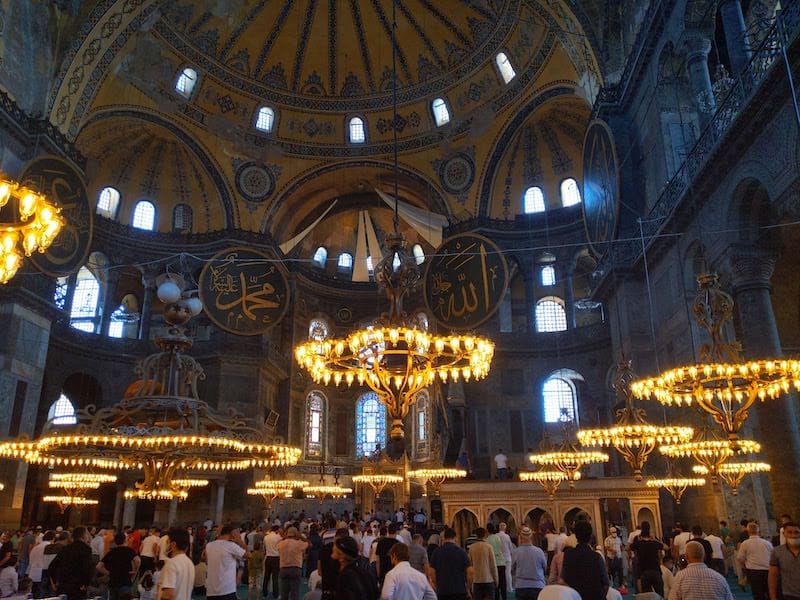
We wind through the nooks and crannies of Sultanahmet’s streets, letting the muddled frenzy of tourist traps and badly remodeled buildings fall away into the bustling, lived-in avenues of Kumkapı. Once home to long-standing Armenian and Greek communities that were driven out by mid-century pogroms, Kumkapı has become Fatih’s border for new immigrants. Amidst the Bangladeshi, Kyrgyz, Ethiopian and Syrian import shops, Boris’in Yeri is still selling its cloud-like kaymak (clotted cream), just as it did to its Armenian clientele when it opened in 1936.

We snag a table outside and order sunny-side up eggs dotted with sucuk (spicy beef sausage) and a heaping plate of kaymak drizzled in bal (honey). Our visitors are immediately glad to have skipped the hotel breakfast when this simple feast arrives: the egg yolks are a vibrant, healthy orange and the garlicky smell of sucuk hits the nose. Thick yet airy, the bal kaymak is celestial. When the original owner, Boris, was alive, he used to surprise his friends with trays full of kaymak rolls, undoubtedly ensuring his spot as a caterer in heaven. We’re tempted to order more, and discuss swinging by the Theodosius Cistern, but our next stop beckons: off to the Grand Bazaar for coffee.
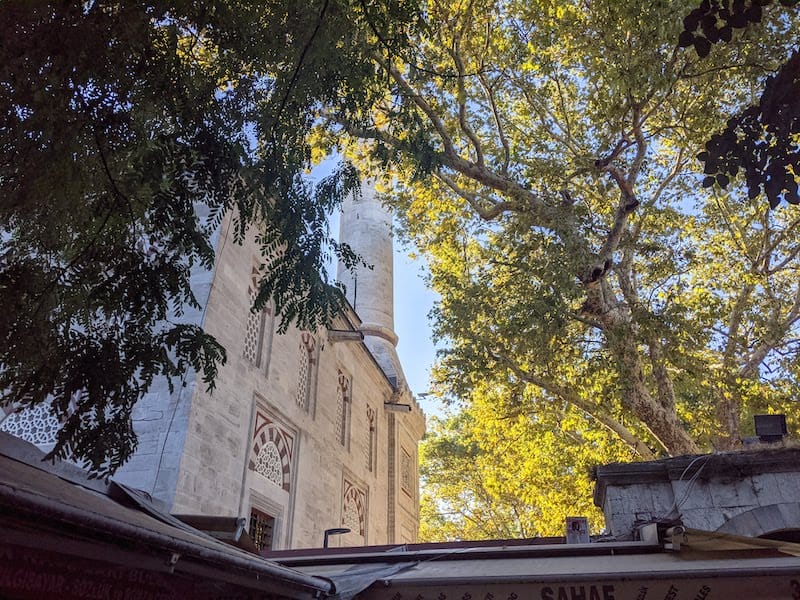
Groups of lanterns sway above us like brightly colored birds. Curtains of gold chains glint from shop windows. We are in a kaleidoscope of sights, scents and treasures that are all for sale – an Orientalist consumer dream. Part of the ritual of buying in the Kapalıçarşı (literally, covered market) is to chat with shopkeepers, accepting their offer of drink (for us, Turkish coffee, black, thanks!) and making small talk while haggling over wares. A cheap cup of joe is a small gift for the serious shopper, and we prove ourselves worthy after our friend sifts through piles of Uzbek suzani textiles and purchases an embroidered jacket in Cebeci Han. For those who’d rather pay the Grand Bazaar premium for their brew, Şark Kahvesi is the celebrity-studded spot. However, since that part of the market’s too-sleek restoration finished, we prefer the more kitschy Çinli Cafe, which has a raucous view of an intersection of rug sellers.
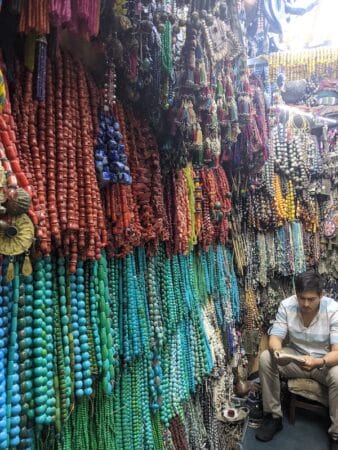
As a rule, we reserve our Grand Bazaar outings for when guests are in town, letting ourselves enjoy its labyrinthine alleys through the starry eyes of a tourist instead of the weary gaze of a local frustrated by the aforementioned renovation, hustlers and influx of highly priced generic goods made in China. We also take the opportunity to quality test Gülebru Kantin, our go-to Kapalıçarşı döner kebab. When done wrong, which is most-often the case in Istanbul, döner is a dry affair, massive low-grade meatsicles packed onto a spit, lacking in flavor and tenderness. You’ll be hard-pressed to find a decent döner on any tourist-tred paths, but at Gülebru, cuts of meat are marinated before being staked through each morning and roasted along a charcoal fire. Today, Mustafa mans the spit, expertly shaving crisp pieces onto a warm pita. It’s old school and, our guests agree, it’s good. Mustafa’s stall is also a spot that draws the bazaar’s workers, meaning the meat can run out well before dinner time. In that case, we head just outside to Döner Bank or to the trough at Aynen Dürüm for a stand-up Adana kebab.
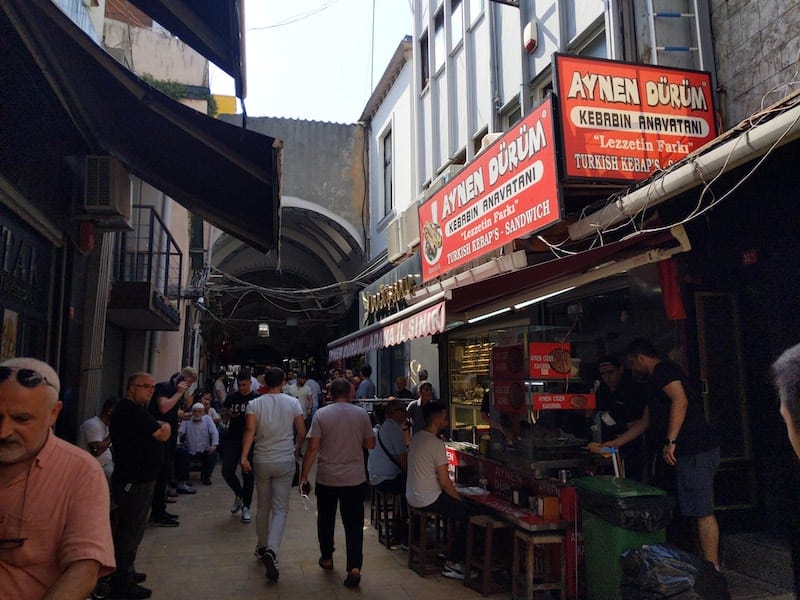
Our appetites satisfied for now, we wind back through the bazaar and exit through the peaceful oasis that is Sahaflar Çarşısı, the bookseller’s market, rife with pages of Ottoman calligraphy and the smell of old books. It’s time to walk-off our daytime meals and take a beat in the courtyard of Suleymaniye Mosque, architect Mimar Sinan’s most palatial work. We got used to passing over the more-famous Blue Mosque (which only just wrapped up a five-year restoration in April) for the quieter, airier and grander Suleymaniye, positioned on a hill overlooking the Golden Horn. From the mosque’s terrace, a 180-view of the water unfolds, and in further pursuit of this panorama we climb the steps to Mimar Sinan Teras Cafe for a spot of tea.
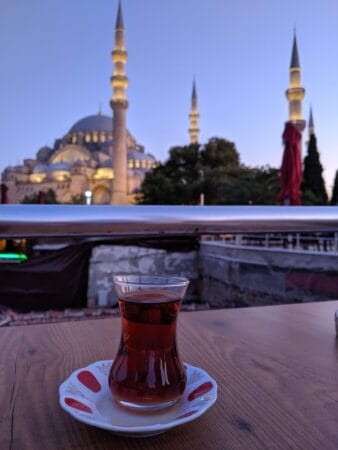
Unlike döner, a bad glass of çay is the exception and not the rule in Turkey, a land of perpetual tea drinkers. The rare departure is at restaurants with high turnaround (where they’d rather you leave than linger over multiple glasses) and spots with a view (where you’re paying for the fresh sea air). The row of terrace cafes on this northern slope of Fetva St., touting tropical nargile (waterpipe) flavors and microwaved kebab meals, belong in that latter category, but we exonerate Mimar Sinan Cafe of all charges when we make it to their uncanopied roof. Up here, the exhaust and exhaustion of the city slips away. We are one with the seagulls, and hey, the tea is pretty good too.
Our çay break over, we descend into the tumultuous streets of Tahtakale. Where the Grand Bazaar entices with its elaborate displays and promise of one-of-a-kind wares, in Tahtakale you will understand just how cheap and how common those souvenirs really are. When on the hunt for absolutely anything in Istanbul – pastry bags and icing tips? Knife sharpeners and copperware? Lengths of rope and evil eye beads? – head to Tahtakale, there it will be.
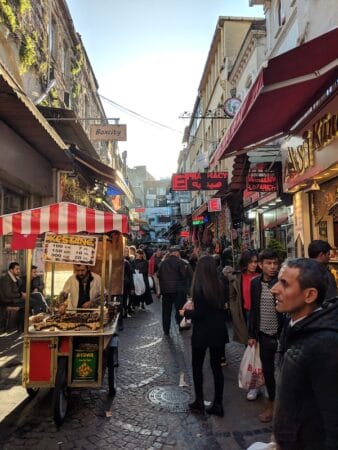 Also here is Lezzet-i Şark, a fun pit stop right in the thick of things, perfect for sampling coal-cooked künefe, a dessert of cheese covered in shredded phyllo, baked until melty, then soaked in simple syrup. We ask for one plate az şekerli (less sweet), and dig into the deliciously gooey mess.
Also here is Lezzet-i Şark, a fun pit stop right in the thick of things, perfect for sampling coal-cooked künefe, a dessert of cheese covered in shredded phyllo, baked until melty, then soaked in simple syrup. We ask for one plate az şekerli (less sweet), and dig into the deliciously gooey mess.
On a sugar buzz, we pop around the corner to show off Rüstem Paşa Camii, our favorite of Istanbul’s many, many mosques. Easy to miss, it sits on the roof of a handful of Tahtakale shops, a little sanctuary above all the noise. Its interior is covered in stunning blue tiles, making it definitionally a hidden gem of the city. Another favorite of ours is the Kurukahveci Mehmet Efendi stand just at the entrance of the Spice Bazaar. The long line for bags of freshly ground Turkish coffee may be intimidating, but it moves quickly and makes for the perfect souvenir – our guests are thrilled, and we are happy for the chance to replenish our stock.
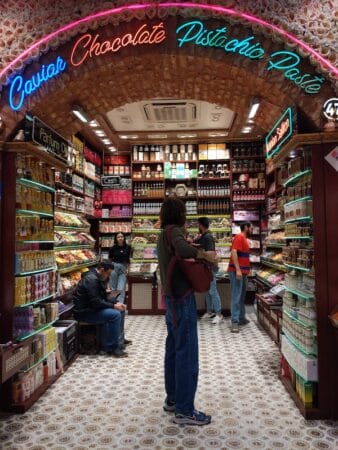
Having spent so much time in the Spice Bazaar’s surrounding streets, we make quick work of the market’s T-shaped, refurbished interior, sampling Turkish delight from vendors as they wave trays under our noses. Were our guests traveling back to IST, we would have secured an early dinner reservation at Pandeli Restaurant. This elegant, century-old spot, which you enter from within the Spice Bazaar, was once buried treasure for many years, closed for remodeling before reopening in new hands in 2019. A couple years later, Michelin awarded the well-crafted mezes and traditional, tasteful interior a Bib Gourmand. With our full day of roaming, we might have arrived too late – in which case, we’d have a great excuse to walk over Galata Bridge and have an unparalleled fish wrap at Balık Dürüm Mehmet Usta. We’d close out the night with bar-setting baklava and a final cup of çay at Karaköy Güllüoğlu and, if time permits, a cocktail at Aşeka.
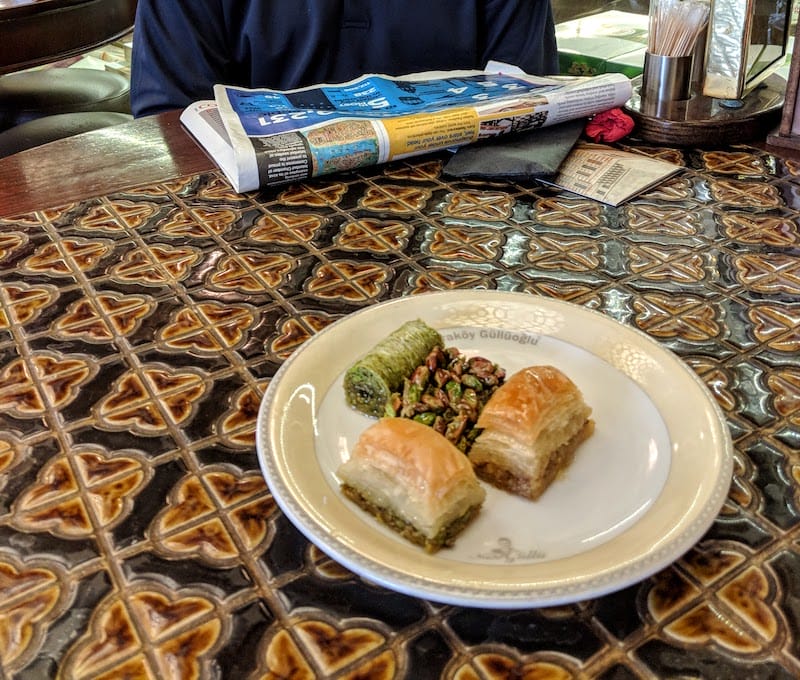
But our guest’s nighttime trek to SAW is ahead of us, so we decide to flaunt the best of Istanbul on both continents instead. From Eminönü Pier, we board a commuter ferry to Kadıköy and order glasses of tea from the çaycı onboard. The satisfaction of a perfectly timed trip unfurls in front of us: As the sun sets behind the Old City, the Hagia Sophia and Blue Mosque become silhouettes atop a flaming orange sky. By the time we disembark, our favorite hour begins settling over Istanbul, the city lights flickering on in anticipation of nightfall.
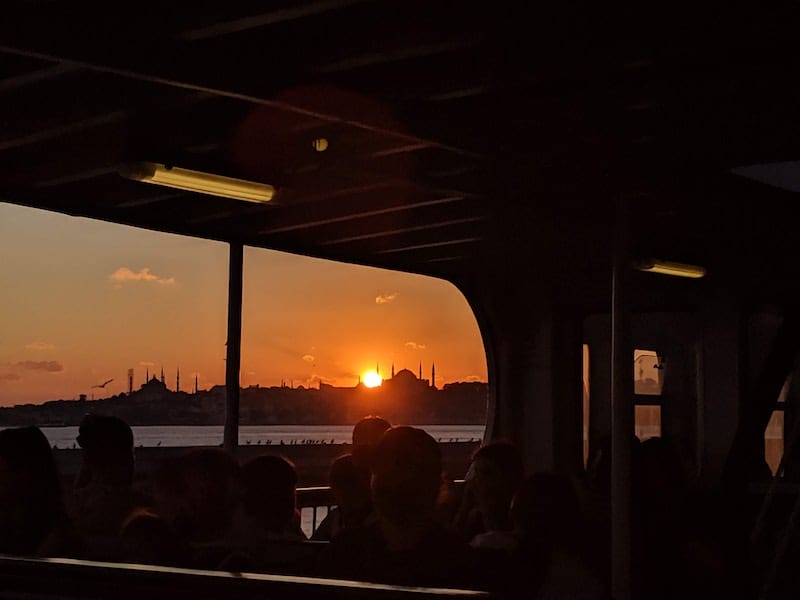
Before it grows too dark, we cut through Kadıköy’s center and make a beeline for Çiya Sofrası. Always seasonal, always reliable, Çiya has never disappointed. Chef Musa Dağdeviren resurrects traditional Anatolian dishes with great success, as well as tender, excellently prepared kebabs. This time of year we crave the cherry-studded, sweet and sour kirazlı kebab and, today, there was an extra special surprise in the form of an earthy, yogurt-based stew of fresh garlic and lamb. We order a lot. The pistachio-stuffed şöbiyet, a phyllo dessert similar to baklava, balances well with Çiya’s herby thyme tea, and we can’t help but push our guests to try the candied walnut and eggplant with a dollop of heavy kaymak – otherworldly.
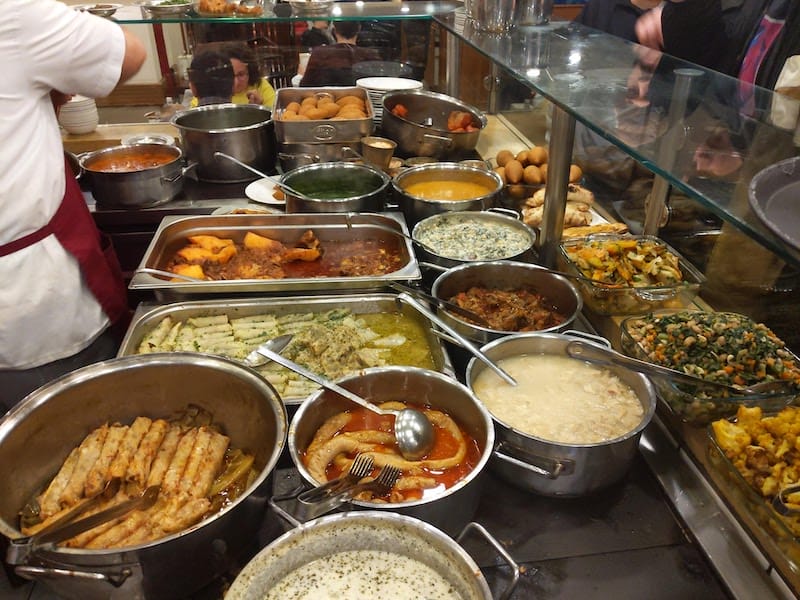
Before saying our goodbyes, we can’t not cap the long day with a well-deserved and well-crafted drink at Fahri Konsolos in Moda. Burak Ayaz, the tiny cocktail joint’s 20-something recipe composer, is a virtuoso behind the bar, pouring out creative, poetic libations like Istanbul has never seen.
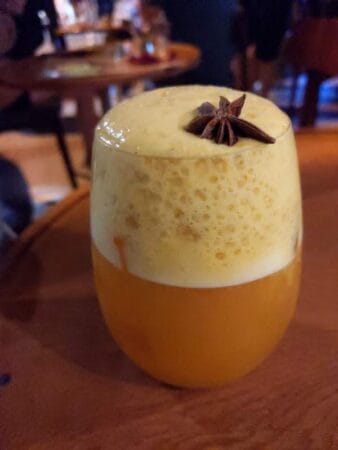 Each drink fuses a bit of something totally local with something faraway and exotic, and you can request non-alcoholic versions as well. Our current favorite, the seasonal Çidem, incorporates sour cherry, saffron, whiskey, sage and orange blossom. A Fahri-classic that is always on the menu, the smoky Leb û Derya, wins our companions’ hearts: mezcal, beets, apple cider vinegar, mustard sprouts and a touch of agave nectar. Only a genius could make those flavors sing.
Each drink fuses a bit of something totally local with something faraway and exotic, and you can request non-alcoholic versions as well. Our current favorite, the seasonal Çidem, incorporates sour cherry, saffron, whiskey, sage and orange blossom. A Fahri-classic that is always on the menu, the smoky Leb û Derya, wins our companions’ hearts: mezcal, beets, apple cider vinegar, mustard sprouts and a touch of agave nectar. Only a genius could make those flavors sing.
The song of Istanbul thoroughly heard, we pack our visitors into a cab and send them off to the airport a good three hours before departure, satiated and satisfied.
Published on July 17, 2023
Related stories
February 28, 2024
Food Tours NDQuick Bite: This full-day Istanbul market tour draws from our best-of list in the European side’s Karaköy neighborhood and the Asian Kadıköy, tied together by a Bosphorus crossing, visiting two markets on two continents. Our favorite Istanbul experiences include exploring the eateries in local markets and crossing the Bosphorus on the public ferry. The route for…
March 30, 2022
IstanbulQuick bite: Far from the tourist trail, get a taste of one of the last bastions of classic Istanbul flavors, including bread fresh from the tandir oven, a mind-boggling assortment of meze, sizzling kebab, old school ice cream and much more. On this full-day food tour, we will dig deep into the culinary traditions of…
February 18, 2016
IstanbulQuick Bite: This full-day Istanbul market tour draws from our best-of list in the European side’s Karaköy neighborhood and the Asian Kadıköy, tied together by a Bosphorus crossing, visiting two markets on two continents. Our favorite Istanbul experiences include exploring the eateries in local markets and crossing the Bosphorus on the public ferry. The route for…







































